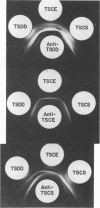Abstract
Three different extracts of Thermoactinomyces sacchari were analyzed for their antigenicity and physical-chemical properties. Rabbit antiserum to each preparation, tested by immunodiffusion in gel, demonstrated that the most potent immunogen was that prepared by the double-dialysis method. This extract also contained the greatest number of precipitating antigens as detected by gel filtration. All extracts, analyzed by column chromatography on Sephadex G-75, were heterogeneous in that they contained large- and small-molecular-weight fractions. Precipitins in each extract were detected in column eluates of relatively low ultraviolet absorption and were of a similar molecular size range. Chemical analysis of purified antigens demonstrated protein and carbohydrate. The culture supernatant contained the greatest amount of carbohydrate (66%), and the soluble extract of bacterial cells contained the greatest amount of protein (68%). Several antigens were partially sensitive to the proteolytic enzymes Pronase and trypsin, but none was sensitive to lysozyme. These results demonstrate that there are multiple-antigen systems in T. sacchari and that, of the samples analyzed, the double-dialysis method of antigen preparation yields the most potent antigens.
Full text
PDF






Images in this article
Selected References
These references are in PubMed. This may not be the complete list of references from this article.
- Edwards J. H. The double dialysis method of producing farmer's lung antigens. J Lab Clin Med. 1972 Apr;79(4):683–688. [PubMed] [Google Scholar]
- GRABAR P., WILLIAMS C. A. Méthode permettant l'étude conjuguée des proprietés électrophorétiques et immunochimiques d'un mélange de protéines; application au sérum sanguin. Biochim Biophys Acta. 1953 Jan;10(1):193–194. doi: 10.1016/0006-3002(53)90233-9. [DOI] [PubMed] [Google Scholar]
- Goudie R. B., Horne C. H., Wilkinson P. C. A simple method for producing antibody specific to a single selected diffusible antigen. Lancet. 1966 Dec 3;2(7475):1224–1226. doi: 10.1016/s0140-6736(66)92305-1. [DOI] [PubMed] [Google Scholar]
- LOWRY O. H., ROSEBROUGH N. J., FARR A. L., RANDALL R. J. Protein measurement with the Folin phenol reagent. J Biol Chem. 1951 Nov;193(1):265–275. [PubMed] [Google Scholar]
- Lacey J. Thermoactinomyces sacchari sp. nov., a thermophilic actinomycete causing bagassosis. J Gen Microbiol. 1971 Jun;66(3):327–338. doi: 10.1099/00221287-66-3-327. [DOI] [PubMed] [Google Scholar]
- Salvaggio J., Arquembourg P., Seabury J., Buechner H. Bagassosis. IV. Precipitins against extracts of thermophilic actinomycetes in patients with bagassosis. Am J Med. 1969 Apr;46(4):538–544. doi: 10.1016/0002-9343(69)90073-4. [DOI] [PubMed] [Google Scholar]
- Seabury J., Salvaggio J., Buechner H., Kundur V. G. Bagassois. 3. Isolation of thermophilic and mesophilic actinomycetes and fungi from molyd bagasse. Proc Soc Exp Biol Med. 1968 Nov;129(2):351–360. doi: 10.3181/00379727-129-33319. [DOI] [PubMed] [Google Scholar]
- TENDLER M. D., BURKHOLDER P. R. Studies on the thermophilic actinomycetes. I. Methods of cultivation. Appl Microbiol. 1961 Sep;9:394–399. doi: 10.1128/am.9.5.394-399.1961. [DOI] [PMC free article] [PubMed] [Google Scholar]





